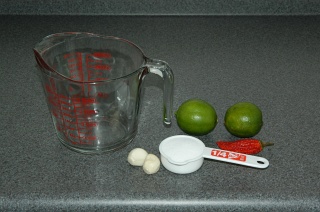 To prepare the marinade, you'll need two limes, 1/4 cup table salt, 2 cloves of garlic, and a chile of your choice.
To prepare the marinade, you'll need two limes, 1/4 cup table salt, 2 cloves of garlic, and a chile of your choice. 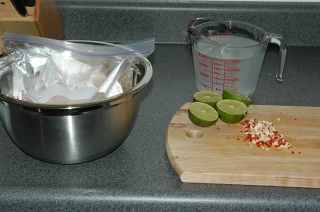 Cut the limes in half (to prepare for juicing) and mince the garlic and chile pepper. Pour the salt into a large measuring cup and add enough water to make four cups (about 1 liter). Stir the salt water until the salt has dissolved. This is also a good time to prepare the chicken. The marinade will be enough for two whole chickens (cut up) or 8 pounds of drumsticks (my favorite). Put all the chicken in a large resealable plastic bag. I called this mixture a marinade instead of a brine because not only does the solution include salt, but also acid (lime juice). A soaking solution with acid should be referred to as a marinade.
Cut the limes in half (to prepare for juicing) and mince the garlic and chile pepper. Pour the salt into a large measuring cup and add enough water to make four cups (about 1 liter). Stir the salt water until the salt has dissolved. This is also a good time to prepare the chicken. The marinade will be enough for two whole chickens (cut up) or 8 pounds of drumsticks (my favorite). Put all the chicken in a large resealable plastic bag. I called this mixture a marinade instead of a brine because not only does the solution include salt, but also acid (lime juice). A soaking solution with acid should be referred to as a marinade. Juice three of the lime halves (using a juice extractor or a reamer) and add the juice to the salt water. Add the minced garlic and chile. Stir once to mix. Pour this into the plastic bag and reseal the bag. Try to make sure all the chicken is submerged in the marinade. With a fairly full bag, you may need to squeeze out almost all the air to accomplish this. Place the bag in a container and place in the refrigerator for at least one hour. Two hours is best, but any longer, and the chicken may become too salty. (The minimum ingredients in this marinade are the water, salt, and lime juice. The garlic and chile can be omitted if you don't have them handy.)
Juice three of the lime halves (using a juice extractor or a reamer) and add the juice to the salt water. Add the minced garlic and chile. Stir once to mix. Pour this into the plastic bag and reseal the bag. Try to make sure all the chicken is submerged in the marinade. With a fairly full bag, you may need to squeeze out almost all the air to accomplish this. Place the bag in a container and place in the refrigerator for at least one hour. Two hours is best, but any longer, and the chicken may become too salty. (The minimum ingredients in this marinade are the water, salt, and lime juice. The garlic and chile can be omitted if you don't have them handy.)After the two hours, preheat your grill and remove the chicken from the refrigerator and take each piece out of the plastic bag and rinse it off in the sink. If you don't rinse the chicken off, then the salt water lingering on the surface will make the chicken too salty.
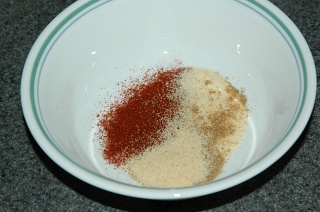 For seasoning the surface of the chicken, combine 1 tablespoon paprika, 1 tsp. onion powder, 1 tsp. ground coriander seed, and 1 tsp. garlic powder. Feel free to try different spice and herb combinations to fit your taste.
For seasoning the surface of the chicken, combine 1 tablespoon paprika, 1 tsp. onion powder, 1 tsp. ground coriander seed, and 1 tsp. garlic powder. Feel free to try different spice and herb combinations to fit your taste.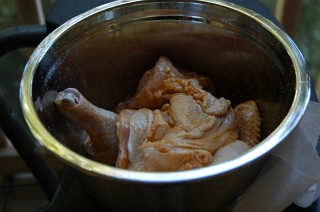 Toss the chicken with 1 Tbs. olive oil, the juice from the remaining half lime, and the seasonings prepared in the previous step. Using your hands to mix the chicken with the seasonings is the fastest way I know of to get an even distribution.
Toss the chicken with 1 Tbs. olive oil, the juice from the remaining half lime, and the seasonings prepared in the previous step. Using your hands to mix the chicken with the seasonings is the fastest way I know of to get an even distribution.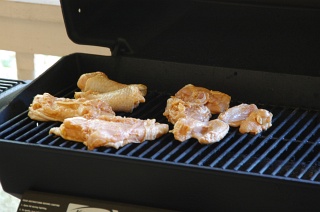 Place the chicken pieces on the grill, being careful not to crowd the pieces. Grill, turning every five minutes, until white meat reaches 165°F - 170°F and dark meat reaches 175°F.
Place the chicken pieces on the grill, being careful not to crowd the pieces. Grill, turning every five minutes, until white meat reaches 165°F - 170°F and dark meat reaches 175°F. Remove the chicken from the grill and let stand for five minutes before serving.
Remove the chicken from the grill and let stand for five minutes before serving.Related Articles
Lime marinade
| 4 cups (1 L) water | dissolve | mix |
| 1/4 cup (75 g) table salt | ||
| 1-1/2 limes | juice | |
| 2 cloves garlic | mince | |
| 1 chile | mince |
Spice Rub #2
| 1 Tbs. (7 g) paprika | mix |
| 1 tsp. (2.5 g) onion powder | |
| 1 tsp. (2 g) ground coriander seed | |
| 1 tsp. (3 g) garlic powder |
Grilled Chicken
| about 4 cups lime marinade | marinade in plastic bag in fridge 2 hours | ||
| 8 lbs. (3.5 kg) chicken parts | rinse | mix | grill until white meat 165°F and dark meat 175°F |
| 1/2 lime | juice | ||
| 1 Tbs. (15 mL) olive oil | |||
| about 2 Tbs. (15 g) spice rub #2 |
Related Articles

Can lemon juice be substituted for lime? Also, how much volume does a typical lime produce? (in case I want to just buy as a liquid)
Baking would produce good results, but not the same as if you grilled it. I suggest elevating the chicken on a wire rack while baking at 350°F until the chicken is done and juices run clear (about 40 minutes to an hour). You'll probably want to flip the chicken parts once during cooking.
Baking ona wire rack should keep the chicken elevated from the juices so you won't get a soggy exterior.
Sure, lemon juice is a great substitution. One lime typically yields about an ounce of lime juice. So, use 2 tablespoons of lemon or lime juice from a container for each lime you were planning on using.
It should be noted that lemon juice has higher acidity than lime juice, but I don't think it'll make such a big difference in this recipe. More or less lemon/lime can make a difference to the flavors, but you may find that you prefer the taste of more lemon juice (if you use two lemons, it'll produce about 50% more juice than two limes...)
Eli, a mechanical engineer
Ckeck out the brining article: http://www.cookingforengineers.com/article.php?id=70
In the UK, meat, particularly intensively-reared pork and chicken, is often sold with added water, salt and sugars, which is, I'm sure, a commercial form of brining. However, this is considered a bad thing, and discerning shoppers will avoid this meat and go for a more expensive option (often, free-range &/or organically reared animals).
Yet on the other side of the Atlantic, home brining is becoming an increasingly used technique - is this because you only have access to poor quality meat? Surely a good piece of meat, properly cooked, doesn't require added water, and it certainly doesn't need added salt!
I have also used the paper clip S hook for pork chops in the oven with great sucess.
first time posting (Eng from Australia)
Correct me if Iím wrong but I believe the 'brining' of meat you are talking about is more of a pickling of meat to help preserve the meat.
A beef product that is pickled in the same fashion in the American market I believe is called corned beef.
I do not believe this is the same sort of brining using in this recipe, as you are soaking the meat for a short time (1-2hr). While you will find the meat you are talking about fwendy is soaked for quite a long time(days) and is done to help preserve the meat first then add flavour as a second, while brining first point is to help deliver flavour into the meat (salt solution is used as a flavour carrying medium) hence the addition of lime and what not's in the solution.
As for having to wash the chicken, this only help remove excess salt on the surface of the chicken, as you don't want a salt mummified pieces of chicken after cooking.
Having an Asian back ground, our family has been using brining and marination for almost all our cooking, this is irrespective of the meat quality, its all about the flavour.
For me I even brine my beef Steaks <looks around for people about to throw object at him>
Of cause only for a short time, but I have been know to brine a steak for up to 6 house. More care is needed with regards to salt, but otherwise it adds great flavour to the meat.
If you whish to try steak brining, below is a basic solution, no qty have been given just bry by taste, but please use little salt.
Wine (red or white up to taste)
dark soy source, mushroom flavour if you can get it (less salty and more flavour)
pepper (to taste)
sugar
1/2 fresh garlic clove minced
soak meat in this solution for Ĺ hr before cooking and cook to tasteÖ then using the fon left in the pan add the remanning brine solution and make a source out of it.. yum..
The greatness of brining :)
I agree with HowardHuhn, that broiling would give a better result then just oven. The higher direct heat will give it that char flavour... mmm carbon
sorry, if my post is a little long, great site michael
.......... While you will find the meat you are talking about fwendy is soaked for quite a long time(days) and is done to help preserve the meat first then add flavour as a secondl
No, I'm not talking about pickling or corning, I'm talking about the industrial process of briefly soaking meat in brine to add bulk to the product as it absorbs the water. To my knowledge this is only done with cheaper grades of meat, and is mentioned on the label as added water, sugar and salts.
As I said in my earlier post, most people would shy away from this meat as being inferior, not to mention the fact they are being asked to pay for added water.
I'm just interested in why untreated meat is so dry that it needs to be brined - I suspect it's the modern practice of rearing leaner animals, in the case of pork, and the accelerated growth of intensively reared chickens, which leaves the meat bland and tasteless.
I think the pickling process works by using stronger brine to draw out water from the product (probably by osmosis, in this case).
Yes, in general meats are injected water and salt solutions to "increase flavor" (and, in my opinion, to reduce the amount of meat they are actually selling you per pound). I should have noted at the begining of this article to NOT purchase chickens with salt water added as this will end up exceedingly salty. Having the presalted chicken sit in lime water wouldn't achieve quite the same results either as the meat does not begin to actively draw in the lime juice - you have to hope some of it seeps in through natural random motion and not actively through osmotic pressure.
Brining, in this case, serves a couple purposes. It gets salt and lime juice into the flesh of the meat to provide flavor (not just on the outside but also on the inside of the chicken). It also makes the meat capable of taking on more water. This is nice because cooking it over the direct heat of the grill can often dry out chicken pieces (like breasts) if you start chatting with your guests or step inside to give your sous chef a kiss. The brining helps to ensure that the chicken remains juicy even if slightly overdone (I guess we could say it widens the window of perfect doneness).
Modern meat does have a tendency to be leaner, especially in America. For a number of years everyone was afraid of animal fat (and to take a random survey of my friends and coworkers, this fear still persists) and so chickens and pigs were bred to be leaner and leaner. To this day, chicken breast is the most popular cut of chicken - but in my mind plain chicken breast is so lean that it has become bland and flavorless. My favorite? Drumsticks. Nice dark meat filled with fatty, juicy goodness and it comes with it's own popsicle style serving stick! This trend of having leaner chicken and pork may not extend to the rest of the world... my wife tells me that growing up in China, the pork is much fattier and more flavorful than the cuts that we find in the U.S.
Doubled the salt
Doubled the lime
Halved the marination time
Used skinless drumsticks
Skipped the rub
A word about the skinless drumsticks: Normally, I agree that the skin is the best part of the chicken. Grilling over direct coals, though, I like to take off the skin. The flesh underneath browns up terrifically and it doesn't need constant attention to avoid burning.
I also believe, as stated before, there's a limit, by law to the "added moisture" you can put into meat.. (added weight means you pay for more meat than is actually there)
As to why it works - when you soak the meat in your salt solution, it will, via osmosis, move salt into the meat to achieve equilibrium with the surrounding water.
Now that salt is inside the meat, it causes the proteins to denature and interact with each other.. and allows the meat to retain more moisture when it cooks because the proteins/liquids are formed with each other and less likely to be released with cooking.
(paraphrased from an issue of Cook's Illustrated)
You're right! I fixed the error. Thanks!
As I don't have a charcoal grill, I cooked the chicken on a grill plate over high heat first and finished the cooking in a hot air oven.
I suspect the difference between industrial salt adding and home *brining* is that when it happens at a factory it's gross, low quality salt and possibly includes other preservatives. A good brine with sea salt would make all the difference.
The Tequilla gave it a nice flavor that sat beneath the lime. Everyone liked the recipe that time (except the breasts weren't grilling right because they were a little too thick, so it took longer than expected).
This was the first recipe I tried from this site and it was an unequivocal success. I made this chicken and the "Garlic Roasted Potatoes" from another recipe I located here. The preparation of both dishes was made very simple by the excellent and detailed instructions and both recipes were a big hit with the whole family.
Thanks Michael!
Sherrick
Thanks,
Ben
It turned out great(I made drumsticks and thighs). I was really getting tired of the usual baked chicken with a few spices on it and some bbq sauce on it, but this was a wholly different experience. It was deliciously juicy, and had an excellent flavor. I'll definately be using this recipe again. Thanks. :)
you might also want to make a note to avoid this kind of brine/marinade with kosher birds, which are already hell of salted.
i always try to marinade or brine whenever i have a chance, even if only for an hour. it always helps.
Julia
Ridsbabe@aol.com
That should be fine. Just make sure you refrigerate it after brining and before cooking.
I am wondering if it's ok if I put the chicken in the brine for 2 hours in the morning, take it out and rinse it, but not cook it until that evening. Will this make a difference?
That should be fine. Just make sure you refrigerate it after brining and before cooking.
Thanks for the tips...it was a HUGE hit with my husband and my brother, who usually do the cooking on our house!!
It was easy to make and delicious.
What else can one ask for?
thanks for your simple and great advice
Luke
Pound to 1/2" thickness 4 boneless chicken breasts; marinated in juice of 2 limes, 8 cloves of garlic crushed, 1/2 tsp cayenne, 1/4 cup cilantro, jalepeno chili (heat to your liking) 3 tbsp olives oil, 1/2 tsp salt; let soak for 2 hours in fridge.
Prepare your favorite guacamole from scratch.
Get: a can of poblano chili's or roast altertnatively and monterrey jack cheese.
Prepare chipotle mayo by mixing 1/2 cup of good mayonaise with 2 chipotle chili peppers in adobo (with the sauce still clinging to them) finely chopped and refridgerate them
grill chicken breasts over medium hot
Assemble your sandwiches, (we like get a nice crusty baguette, and lightly toast the cut side) by coating one side of baguette with chipotle mayo, topping with a chicken breast, some poblano, cheese and coating the other side of the bread with the guacamole
Ole
Mike
I went through the comments and saw that it should be ok to brine for a couple hours, the day before, pull it out of the brine and rinse off, and leave in the fridge. Another user mentioned adding egg yolk to prevent the lime acid from cooking the chicken (during the refrigeration time). Will I need to add that to the recipe for my purposes?
Thanks!
Greetings
Wonderful site! Every recipe should be written in this detail, conscious about the little things that matter the most.
I baked some turkey the day before (on a generous onion bed, and had some rice with canned corn mixed into it as a side dish and a salad with honey-mustard dressing) and everybody loved it, it was really delicious... except for the meat being a little dry :( I was thinking all day how to do it better, and bang, here it is. Thanks a lot!
Also, the S hook in the oven... Genial! Why hasn't this occurred to me before?!
Best wishes!
tell me, what kind of thermometer do you use? the ones i have seen look too thick for a drumstick or a thigh... i just eyeballed it.
the paperclip is a cute idea, but i'm a little afraid to use it. what exactly is a paper clip made of and what might be imparted to the meat during high temp cooking in the oven? i hate to put a damper on things, but at one time it was considered safe to cook with aluminum :unsure:
As an undergraduate engineer cooking for a flat of 5 undergraduate engineers, this site seems somehow rather appropriate. Love the recipe layout for baking - it's how my own recipes are written up!
thanks for posting!!!! This would be a very perfect dinner for a very special day!